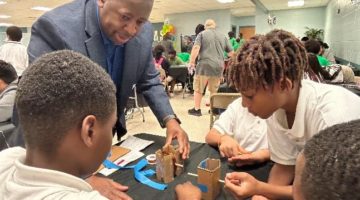 Although it is easy to forget, it only takes one major storm to bring devastation to a particular region. Other than home preparedness, such as securing all windows with shutters and acquiring a three- to five-day supply of food and water for each person, there are other safety measures that the community can put into practice before, during and after a storm.
Although it is easy to forget, it only takes one major storm to bring devastation to a particular region. Other than home preparedness, such as securing all windows with shutters and acquiring a three- to five-day supply of food and water for each person, there are other safety measures that the community can put into practice before, during and after a storm.
Don’t rely on phones
Every family should develop an emergency communication plan, detailing designated out-of-state relatives or friends as a primary contact person. Remember that cell phones and landlines don’t often work during and after a storm, so it is important for families to arrange a local point of contact, in case family members are separated. Also, with the help of social media, people can let their loved ones know that they are okay after a storm.
Are you insured?
In addition to an emergency plan, personal possessions should not be forgotten. It is best to purchase insurance on the more expensive items and take pictures before a storm. If this information is stored on a computer, though, the equipment should be protected as well by being covered and moved to a closet. As for paper documents or personal photographs, they should be placed in a portable plastic storage container so they are protected from the elements and easy to transport if an evacuation order is put into effect.
Leave if told to
If an evacuation is ordered, compliance is necessary. Do not hesitate; leave as soon as possible to avoid traffic, flooded roads or washed-out bridges. Since not everything can be packed into a car or taken to a hotel, make sure to make a pre-assembled hurricane kit and protective clothing a priority.
Some families may need to go to an evacuation shelter, and if that is the case, remember they are designated for safety not comfort. Accommodations are extremely basic, and those who choose to stay in a local shelter should be prepared to sleep on the floor of a common area. Food and water will be provided, but it is recommended that a sleeping bag, pillow and snacks be brought as well.
Remain indoors
It is essential to remain indoors throughout the entire storm. During the peak of the storm, it is suggested that you stay away from windows, close bedroom doors and remain in hallways, bathrooms and/or living rooms. Do not attempt to open windows or doors to see what is happening outside. Wind currents are especially strong near high-rise buildings. Keep in mind that everything is calm when the eye of the storm passes overhead. But, do not venture outside, as the second half of the storm will follow shortly.
After a storm
Being cautious after a storm is just as important as before and during one. There are many dangers, including fire and carbon monoxide. Use caution when using a generator by following all of the manufacturer’s instructions and guidelines, and using the correct sized and type of power cord to carry the electric load.
Marcus Robinson is director of safety and the chief fire official at Broward College. He is available to discuss how to safely operate a generator during a power outage in order to avoid carbon monoxide poisoning, as well as precautions to take when using grills, camp stoves or other gasoline, propane, natural gas or charcoal-burning devices. Robinson can be reached at 954-201-5323 or mrobins2@broward.edu









No Comment